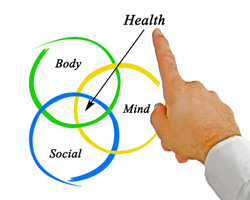
Measurement Issues of Spirituality and Health
 Amy Wachholtz, PhD, Spirituality and Health SIG Co-chair
Amy Wachholtz, PhD, Spirituality and Health SIG Co-chair
John Salsman, PhD, Spirituality & Health SIG Co-chair
Crystal Park, PhD, Spirituality & Health Past Chair
Religiousness and spirituality (R/S) are increasingly shown to be related to myriad aspects of health and well-being. The increased interest in the links among health and psychology of religion has led to increased research in the field and a deeper exploration of R/S. As researchers increasingly include these variables, they face a bewildering array of methods and measures. The proliferation has led to a number of surveys which vary widely in psychometric quality and conceptual validity.
Pain & R/S
The use of religion and spirituality to cope with health issues is increasing (Wachholtz & Sambamoorthi, 2011). Pain is a complex multidimensional experience that has biological, psychological, social and spiritual implications, especially in the context of chronic pain. Even the etiology and type of pain can create different psychosocial changes that significantly impact the pain experience. Previous research has shown that religious and spiritual beliefs, and the trajectory of spiritual growth, are different among individuals with pain compared to the general population (Rippentrop, Altmaier, Chen, Found, & Keffala, 2005). Therefore, when assessing religion and spirituality among pain patients, it is crucial to tailor the assessment to the patient population. One of the crucial areas to distinguish is between pain and suffering. These two areas are often conflated and unfortunately treated as a single entity (and not infrequently treatment involves opioids to treat both). Identifying areas of psychological and existential suffering first, before identifying pain levels, can help ensure cleaner research outcomes and better treatment protocols.
Cancer & R/S
Recent reviews underscore the relationship of R/S with important health outcomes in cancer such as mortality, morbidity, psychological adjustment, and quality of life (Fitchett & Canada, 2010; Peteet & Balboni, 2013; Visser, Garssen, & Vingerhoets, 2010). In the last decade, published studies of R/S in cancer have more than tripled from the amount published in the prior decade. Despite this increasing interest in R/S in cancer patient cohorts, current research methods can limit our understanding of R/S as a predictor of outcomes. There is substantial heterogeneity with respect to clinical and demographic characteristics among persons with cancer and this affects our ability specify the relationship between R/S and outcomes in cancer patients. Moreover, the relevance of particular dimensions of R/S to health outcomes varies across the condition. Thus, it is important to select targeted assessments based on the different needs of individuals at the stages of care: prevention, early detection, diagnosis, treatment, survivorship, or end of life.
Cardiovascular Disease & R/S
Many aspects of Religiousness and Spirituality (R/S) have been shown to be important factors in the domains of cardiovascular health and illness. For example, some types of R/S are related to cardiovascular risk factors such as diet, BMI, and hypertension, while others are more closely associated with dealing effectively with cardiac illness, including coping, adherence, and end-of-life issues (Masters & Hooker, 2013). However, the types of R/S that are most relevant to these different health endpoints differ. It is important for researchers to keep in mind that R/S comprises a range of specific constructs, ranging from denominational affiliation and service attendance, to beliefs and attributions, to relationships with God and one's congregation. Future research on this topic must be based on stronger conceptualizations of the particular aspects of R/S that would be theoretically expected to link to the specific aspects of cardiovascular health or illness under study. One useful source for studying multiple dimensions is the NIA/Fetzer BMMRS (Fetzer Institute/National Institute on Aging Working Group, 1999), which can be found at: http://www.gem-beta.org/public/DownloadMeasure.aspx?mid=1155
Future Directions
Much remains to be accomplished in the field of Spirituality and Health. Future research is focused on solidifying the conceptual domains that are the most critical to physical and mental health for specific medical conditions, and we must be thoughtful about the development of any new measures. There is also an effort to educate researchers interested in adding spiritual or religious questions to their health psychology protocol to ensure that psychometrically valid measures assessing accurate domains are used as part of high quality research in the field.
References
Fetzer Institute/National Institute on Aging Working Group. (1999). Multidimensional measurement of religiousness/spirituality for use in health research: A report of the Fetzer Institute/National Institute on aging working group. Kalamazoo: John E. Fetzer Institute.
Fitchett, G., & Canada, A. L. (2010). The role of religion/spirituality in coping with cancer: Evidence, assessment, and intervention. In W. S. B. J. C. Holland, P. B. Jacobson, M. S. Lederberg, M. J. Loscalzo, & R McCorkle (Ed.), Psycho-Oncology, 2nd edition (pp. 440-446). New York: Oxford University Press.
Masters, K. S., & Hooker, S. A. (2013). Religion, spirituality, and health. In R. F. Paloutzian & C. L. Park (Eds.), Handbook of the psychology of religion and spirituality (2nd ed.) (pp. 519-539). New York: Guilford.
Peteet, J., & Balboni, M. (2013). Spirituality and religion in oncology. CA Cancer J Clin, 63(4), 280-289.
Rippentrop, E., Altmaier, E. M., Chen, J. J., Found, E. M., & Keffala, V. J. (2005). The relationship between religion/spirituality and physical health, mental health, and pain in a chronic pain population. Pain, 116(3), 311-321.
Visser, A., Garssen, B., & Vingerhoets, A. (2010). Spirituality and well-being in cancer patients: a review. Psychooncology, 19(6), 565-572.
Wachholtz, A., & Sambamoorthi, U. (2011). National Trends in Prayer Use as a Coping Mechanism for Health concerns: Changes From 2002 to 2007. Psychology of Religion and Spirituality, 3(2), 67-77.